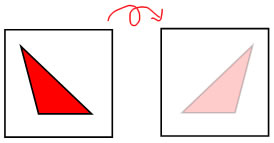
Transformations are changes that are made to a shape. Flips, turns and slides are position changes you make to a shape--they describe motions and/or the result of a motion. In kindergarten and pre-K, children learn to describe relative position using words like: above, below and between. Transformations describe how a movement is made from one place to another.
A flip is also called a reflection. You can see the result of a flip or a reflection in a shape that has line symmetry, so line symmetry is related to the movement that is a reflection or a flip. The word flip comes from the idea of making the movement using a shape drawn on a piece of paper. This is easiest to see with tracing paper. If you draw a shape on tracing paper, and then turn (flip) the paper over, you can see that the shape is still drawn on the opposite side of the paper, and the image you can see has been flipped:

When we flip or reflect a shape, we usually describe it as being flipped or reflected across a line--the mirror line. The vocabulary we use in flipping a shape is a bit different from the what we use when describing reflections. We say that images with a vertical mirror line have "vertical line symmetry", but when we reflect across a vertical line, we usually say we are flipping or reflecting it to the right (or left), and if the line is horizontal we usually say that we are flipping the shape up (or down). Children in primary grades are often asked to identify a transformation as a flip, or are asked to draw a flip. Often, when children are asked to draw a flip a horizontal or vertical reflection line is shown |
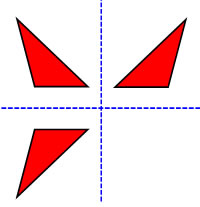 |
In upper elementary/middle school, children see flips again. In grades 5-9, these are usually called reflections, and students learn properties that help them draw reflections by measuring. To find a reflected image by measuring, you need to draw lines that are perpendicular to the reflection line, and measure the distances so that the distance from the original triangle to the line is the same as the distance from the reflected triangle to the line. If you'd like to learn more about reflections in grades 5-9, check out the Math is Fun web sites: http://www.mathsisfun.com/geometry/transformations.html and http://www.mathsisfun.com/geometry/reflection.html |
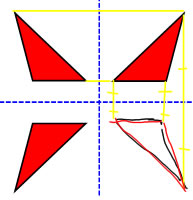 |
A turn or a rotation describes the motion of turning a shape as if it were drawn on a piece of paper, and you turned the whole piece of paper. The usual primary-grades vocabulary is a "turn" and the usual middle-grades vocabulary is "rotation".
| In primary grades, we usually describe a turn by how much it has turned, and we describe those turns as a fraction of a whole turn--so you might see a shape that has been turned by 1/2 turn, or by 1/4 turn either clockwise or counterclockwise. Primary grades children are often asked to identify from a pair of figures whether the transformation was a turn or not, and are sometimes asked to show what a figure would look like after it has been turned. | 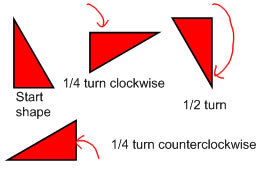 |
In middle grades, we are more specific about our rotations, so a rotation has a number of degrees that the shape is rotated through, and there's a "center" or a "fixed point" that the object is rotated around. Also, in middle grades, we introduce the idea of positive and negative angle measures, so the turn is identified with a positive or negative angle, rather than the words "clockwise" and "counterclockwise". Paying attention to the fixed point as well as the angle of rotation means that depending on the fixed point, the rotated image might be in a different place, even if it was turned through the same angle To learn more about rotations in middle grades, check out Math is Fun: |
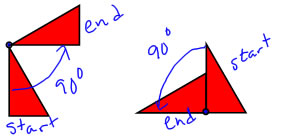 |
In primary grades, moving a shape without turning or flipping it is usually called as slide. In higher grades, it is usually called a translation.
Slides are the simplest transformation--just moving something from one place to another. In primary grades, we usually describe a slide using relative position words, such as "slide down" or "slide to the right and down". In higher grades, we often use grid coordinates, so a translation by (3, -2), means to slide right 3 and down 2. We can also draw an arrow, which in higher grades we'll call a vector, to show how far and in what direction we slide the shape. If I draw an arrow, and ask you to show me where to slide the triangle to, then it's easiest if I start my arrow on a point of the original shape, then you can just make sure that ths same point on the slid-over shape matches up with the point of the arrow. To learn more about translations in middle grades, check out Math is Fun: |
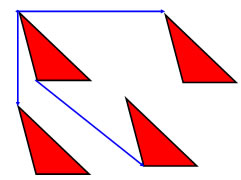 |
There's one other kind of geometric transformation, and that is one that changes the size of an object, but keeps its relative dimensions the same. This is the sort of change that a copy machine makes when you tell it to enlarge or shrink something you are photocopying. In primary grades we might say that the shape has been enlarged or shrunk, and in middle grades we would describe this as a dilation. This transformation isn't a motion transformation, so it's usually in a different lesson from slides, flips and turns.
An interesting thing that you find when you are dilating a shape (like this bird) is that there is also a center of the dilation in the same way there is a center for a rotation--this is the point that you would be using if you were making a 1-point perspective drawing to show depths and distances. You can find out more about dilations at Math is Fun I also included some resizing tips for working on a computer on the video lecture that goes with this topic. |
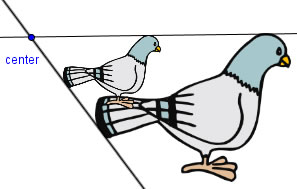 |